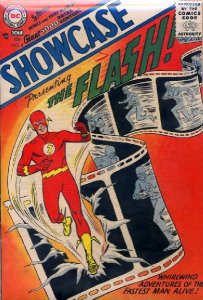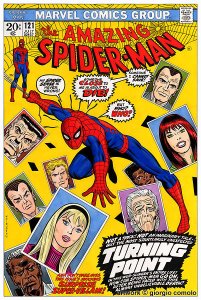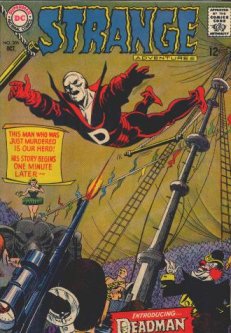|
Part
1
One
For The Ages:
Barbara Gordon and the (Il)-Logic
of Comic Book Age-Dating
Part Two: The Silver Age And Beyond
So,
if June 1938 - the publication of Action Comics
#1 and the arrival of the first fully realized Superman
- marks the inception of both the Golden Age and
the superhero genre as a whole, what date captures
its next significant shift, generally called the
Silver Age?
Again,
there is broad agreement, but not quite as widespread
as Action Comics #1. A handful of individuals
point to November 1955 and the publication of Detective
Comics #225 as the inception of the Silver Age;
this issue is significant in that it first introduces
superhero J'onn J'onzz, the Martian Manhunter.
 While
J'onzz is both one of the first superheroes to emerge
following the post-war slump and continues to populate
the DC Comics universe even today, his debut itself
made little impact. In their Frequently Asked Questions
(FAQ) section at Rec.Arts.Comics.DC.Universe, Jerry
Franke and Elayne Wechsler-Chaput hedge their bet
by offering both J'onzz and the more popular flashpoint
in superhero history, the emergence of the second
Flash, Barry Allen, in Showcase #4 published
September 1956. While
J'onzz is both one of the first superheroes to emerge
following the post-war slump and continues to populate
the DC Comics universe even today, his debut itself
made little impact. In their Frequently Asked Questions
(FAQ) section at Rec.Arts.Comics.DC.Universe, Jerry
Franke and Elayne Wechsler-Chaput hedge their bet
by offering both J'onzz and the more popular flashpoint
in superhero history, the emergence of the second
Flash, Barry Allen, in Showcase #4 published
September 1956.
In
fact, Flash's Showcase #4 ranks as the second
most expensive Silver Age book, according to Overstreet
listings, outpacing the less valuable Detective
Comics #225 ranked #9 (1999: 71).
"The
beginning of the Silver Age is Showcase #4,
the first appearance of the second Flash,"
says Busiek definitively (Lewis, 2002). And Coogan,
who overlaps the Silver Age with Schatz's Classic
stage where "conventions reach 'equilibrium'
and are mutually understood by artist and audience,"
concurs with Busiek. Dashiell also affirms Showcase
#4, saying that "the general consensus is that
the first appearance of the modernized Flash was
the beginning of the Silver Age" (1998: 80).
But,
this returns us to the conflict with the fully realized
Superman versus his earlier incarnations. Mougin
is quick to point out that, though Showcase
#4 is the first appearance of the new Flash, it
isn't until 1959 that Barry Allen inherits his own
monthly title. Of course, one has to ask, what is
significantly different from the Flash in Showcase
#4 and the Flash in Flash #105 almost three
years later? The answer: Next to nothing. The essence
of Barry Allen remains the same, making the later
headlining and later date irrelevant.
Out
of fairness, a brief summary of the potential Silver
Age conclusions seems warranted, even if ultimately
fruitless. Mougin implicates a number of suspect-dates:
Some, he says, "place it at 1970, the year
in which Jack Kirby left Marvel and started up the
Fourth World saga at DC and in which Denny O'Neill
and Neal Adams began their Green Lantern/Green Arrows.
Still others [such as Mougin himself] would date
it at 1972, the year in which Stan Lee quit writing
for Marvel and gave his editorship to Roy Thomas"
(Mougin, 1997: 72).
The
Superman Through the Ages! website, also suggests
publisher- and staff-driven alterations that trigger
both the Silver and subsequent Bronze Age. Whereas
Mort Weisinger gained "sole control over the
character" and re-enlisted Siegel "to
DC [Comics] in 1959 to write the adventures of his
creation once more," Siegel's mid-60's departure
and Weisinger's 1970 handing-of-the-baton to Julie
Schwartz signals the change of era for Semich (2003).
 Franke
agrees with both Weisinger and Kirby's significance
in closing the Silver Age, and Wizard magazine
cites all of the above in addition to the three-cent
price-hike and Marvel Comics' liberating distribution
deal as all signs of the time. They also feature
Busiek's "last gasp of the Silver Age […]
the death of Gwen Stacy," Spider-Man's first
love in Amazing Spider-Man #121 circa June
1973 (Lewis, 2002). Coogan dates the Silver Age's
passing one month later with the demise of the Green
Goblin in Amazing Spider-Man #122. These
add two plot-driven dates to the heap of possibilities,
which is the point: a different criterion guides
each of these determinations. Franke
agrees with both Weisinger and Kirby's significance
in closing the Silver Age, and Wizard magazine
cites all of the above in addition to the three-cent
price-hike and Marvel Comics' liberating distribution
deal as all signs of the time. They also feature
Busiek's "last gasp of the Silver Age […]
the death of Gwen Stacy," Spider-Man's first
love in Amazing Spider-Man #121 circa June
1973 (Lewis, 2002). Coogan dates the Silver Age's
passing one month later with the demise of the Green
Goblin in Amazing Spider-Man #122. These
add two plot-driven dates to the heap of possibilities,
which is the point: a different criterion guides
each of these determinations.
The
motivations and dates are even more scrambled for
the next Age, which only some grant as Bronze. Coogan
sees this as a time of Refinement, where "formal
and stylistic details embellish the form" (2002:
430) - citing Teen Titans #32 in April 1971
as its "arbitrary" beginning (446) - whereas
Wizard calls it "the 'Age of Repackaging,'
where old ideas were spruced up for a whole new
audience" ("One for the Ages", 2001:
90).
Dashiell
cites the changing climate both of the industry
and of the national as a whole; "not only was
the comic book industry experiencing a decline in
sale and personnel shake-ups, but the mood of the
country was changing as deep concerns over civil
rights, women's liberation, and the Vietnam war
were reaching critical mass" (1998: 80). For
reasons such as these, Dashiell sees the roots of
the Bronze Age taking hold back in 1967, "a
pivotal year for several reasons, not the least
of which was the debut of the landmark Deadman
series in Strange Adventures. Like Action
#1 and Showcase #4, I think Deadman represented
the birth of a concept," namely a mature, adult
audience (81).
 Overstreet
might disagree with Dashiell, with Deadman having
little collector's value, certainly not enough to
crack its top 10 - but, then again, its Bronze Age
top 10 is populated by only five genuine superhero
titles, making its definition of the time rather
different from my own. Overstreet
might disagree with Dashiell, with Deadman having
little collector's value, certainly not enough to
crack its top 10 - but, then again, its Bronze Age
top 10 is populated by only five genuine superhero
titles, making its definition of the time rather
different from my own.
This
also makes Busiek's start-point of October 1970,
the first issue of Conan the Barbarian, tricky:
"The Bronze Age is starting even before Gwen
is dead […] There's a new wave of experimentation
going on with sword-and-sorcery books. And the Bronze
Age eventually gets taken over with the success
of Uncanny X-Men" (Lewis, 2002).
Busiek
may inadvertently be supporting Wizard and
Coogan's claims simultaneously: he values the creative
embellishments, but also concedes to the revamped
mutant title's dominance - in fact, Conan
#1 even says on its cover "The First Time in
Comic-Book Form!" (Thomas, 1970: cover,
my emphasis).
Bailey
shares Busiek's year, but not his reason: "To
define it in terms of specific events, we might
begin the Bronze Age with Jack Kirby's departure
from Marvel Comics around 1970" (2000). Coogan,
though, characterizes Kirby's move along with other
mass creative staff changes, the failing of Charlton
Comics, and the publications of the Overstreet Price
Guide and All In Color For a Dime as "extra-textual
events" (Coogan, 2002: 464, note 13), contributing
to, but none singularly signifying, the onset of
the Bronze Age.
All
this may make Dashiell's 1967 seem rather premature,
but other estimates are further belated. Klock suggests
that the Bronze Age, as such, never took place,
and that the Silver Age didn't reach its culmination
until 1986 with Moore's Watchmen and Frank
Miller's Batman: The Dark Knight Returns.
Klock
instead names a "Third Movement" containing
Warren Ellis' Planetary which will narratively
return "to uncover the 'Bronze Age,' the successor
to the Golden and Silver Ages of the superhero,
in their archeology of mysteries" (Klock, 2002:
167). If Klock's contention reveals anything, it
is both how individualized one's dating systems
can be and how difficult the post-Silver Ages are
to discern.
"Was
there a tombstone on the Bronze Age?" was put
to Kurt Busiek: "I think it's a little too
close to tell," he responded in a 2002 interview
(Lewis). For there to be a conclusion to the Bronze
Age, there must be a clear next Age in effect, and,
on that count, there is little agreement at all.
page
3
--
A. David Lewis

|